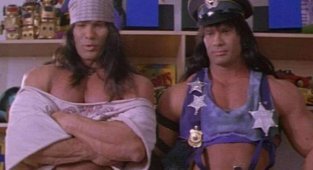In the heyday of Hollywood, in the “golden age” of peplums - in the years not yet overshadowed by the advent of computer modeling of visual effects, creators often shot films of breathtaking scale and scope. 
These paintings still impress today, being an excellent example of the ultimate approach to creativity. Our new review contains ten of the most impressive examples of the genre in terms of “quality and quantity”.
10. Who are you coming?/ Quo Vadis (1951) 
One of the main epics of the fifties of the twentieth century is “Where Are You Coming?” Mervyn LeRoy and Anthony Mann, starring Robert Taylor and Deborah Kerr. Several extras from the film cause “shock and awe” - and by the final episode with Neuron’s circus, the intensity was even raised, involving a couple of tens of thousands of extras and half a thousand horses (as well as other living creatures, including lions). It’s no wonder that the film is still included in all cinema textbooks - now no one even thinks about such a scope.
9. Spartacus/ Spartacus (1960) 
Stanley Kubrick approached the filming of Spartacus with his characteristic perfectionism - so the project with Kirk Douglas and Laurence Olivier (despite creative differences in the team) turned out to be a hit. This was largely due to the ten thousand members of the film crew and another forty thousand involved in filming the combat episodes. Bravo.
8. Cleopatra (1963) 
The film by Joseph Leo Mankiewicz with Elizabeth Taylor and Richard Burton faced a difficult distribution fate - but even from the perspective of 2021, the film amazes with its scale and thoroughness of approach to production. The planned $2 million budget turned into $44 million in expenses (equal to almost $400 million in today's dollars), making the film the most expensive ever made. Alas, the story about the Queen of Egypt was created without a ready-made script (and, in fact, it was shortened by two hours), so it’s no wonder that the film is more like a patchwork quilt - at the same time, in many scenes you literally get goosebumps.
7. Cabiria (1914) 
The founder of the “peplum” genre from Giovanni Pastrone, starring Carolina Catena and Lydia Quaranta, “Cabiria” laid the foundation for modern cinema and formed the basic techniques and approaches that creators still use today. The era of the Second Punic War, described in the work, is stunning both with its crowd scenes and monumental scenery, the likes of which the world has never seen (and, apparently, will never see again).
6. The Ten Commandments (1956) 
The most high-profile film adaptation of the Old Testament - from Cecil B. DeMille with Charlton Heston and Yul Brynner - is still an impeccable example of organizing location filming with a gigantic number of participants. Thus, fourteen thousand people and fifteen thousand animals were involved in the Exodus scene!
5. War and Peace (1965) 
A masterpiece by Sergei Bondarchuk with a whole galaxy of famous actors (Vyacheslav Tikhonov, Oleg Tabakov, Oleg Efremov, Vasily Lanovoy, Anastasia Vertinskaya), the film adaptation of Leo Tolstoy’s classics became the most expensive film for Soviet cinema - no wonder, since several tens of thousands of people were attracted to stage the Battle of Borodino , including one and a half thousand horsemen!
4. Waterloo (1970) 
A logical continuation of the saga described above - now filmed under the patronage of Dino De Laurentiis. One of the largest-scale battles in the history of wars, directed by Sergei Bondarchuk and framed by such stars as Rod Steiger, Christopher Plummer and Orson Welles, turned out to be extremely successful. Well, fifteen thousand soldiers of the Soviet army, who took a detailed course on the rules and canons of warfare in 1815 before filming, made it possible to splash out real rage on the screen.
3. Ben-Hur/ Ben-Hur (1959) 
One of the best productions by William Wyler, with Charlton Heston in the foreground, flaunts a number of scenes that are striking in their monumentality, but the most striking scene of the film, of course, is the chariot race. There are eight thousand extras in the stands, and eighty-two horses compete in the arena! Pure bare nerve and miracles created by stuntmen.
2. Intolerance: Love's Struggle Throughout the Ages (1916) 
Another cornerstone of the historical genre and an example of the unconstrained approach to filming adopted in the “golden age” of cinema. David Wark Griffith gracefully plays with the script structure of four short stories describing different eras, and two and a half thousand extras and enchanting scenery allow you to experience the sensations of “travelling in a time machine.”
1. Gandhi/ Gandhi (1982) 
The most global production in the history of world cinema is Richard Attenborough's "Gudi" with Ben Kingsley in the title role. The story of the spiritual leader of the Indian nation will boast not only voluminous images of heroes and a thick atmosphere, but will also show you a crowd in which three hundred thousand people took part. Yes, yes, that's not a typo. As they say, comments are unnecessary.
0 comments

